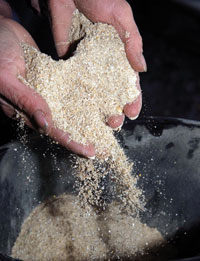Crop Watch: Dealing with frost damage

Sugar beet growers are struggling with unharvestable crops, while pigeons and frost lift in oats are causing concern in many areas, say our Crop Watch agronomists.
In Suffolk, sugar beet growers were struggling to deal with unharvestable sugar beet and limit the effects on following crops, said Frontier agronomist, Brian Ross.
“I think it’s going to be too late to plant winter wheat, as few varieties offer high enough yields this late. So it will have to be a spring crop.”
Growers should disc beet before ploughing, and the longer they could leave the ground before turning over, the better, he said. “This will allow beet material to dry out thoroughly before being incorporated, reducing the risk of anaerobic decomposition, which could compromise germination of the following crop.”
Disease levels in cereal crops in the area were low, thanks to the cold weather, but mildew had been seen on forward wheat and barley crops, he said.
Patrick Stephenson, an AICC agronomist in Yorkshire, said most crops are over-wintering well, except winter oats. “There is no doubt that once the snow cleared and temperatures dropped below -10C, damage was done to these crops.”
It was too early to tell how much damage had been done, but he suspected some would be badly affected.
Cold temperatures had prevented manganese deficiency in wheat, but growers should spray vulnerable areas in the next few weeks, if the weather allowed, said Mr Stephenson.
Wheat bulb fly eggs had just started to hatch and vulnerable fields should be identified, he said. “Depending on risk or sample information, they should be sprayed.”
Late-sown oat crops in the west were also suffering from frost lift, said AICC agronomist Bryce Rham, from Shropshire. “It is too early to say what long-term damage has been done. Because crops have been frozen for so long, there has been no real spring growth as yet. I have recommended that we try to roll most oat crops as soon as conditions allow.”
Winter linseed had also suffered some frost lift, but most crops he had seen looked well. “There is some pigeon grazing on the linseed, but nowhere near as bad as on winter oilseed rape.”
Growers needed a major push on pigeon control to allow oilseed rape crops to start growing away, he said.
In Buckinghamshire, oilseed rape crops that didn’t receive a second phoma spray in the autumn were showing signs of infection, said Nick Brown, agronomist for ProCam. “Given the price of oilseed rape at the moment, I have written recommendations for these in the last few days.”
Blackgrass control had been good in oilseed rape crops that had an application of Aramo (tepraloxydim) earlier in the season, followed by Kerb (propyzamide), he said. “This reinforces the message that earlier control, or suppression – preventing the plants from getting too large and well-rooted – helps.”

